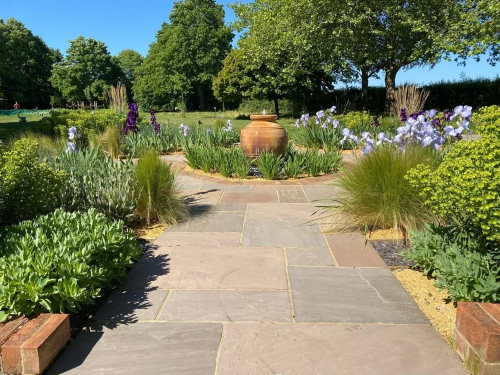Autumn Brown Sandstone
Autumn Brown Indian Sandstone is a versatile choice of garden paving that consists of deep brown earthy tones and natural blends of grey and brown. Autumn Brown sandstone is a colour choice that is very popular with many homeowners in the UK. Low maintenance and easy to pressure wash if needed, Indian Sandstone paving is a very hard wearing and cost effective choice of paving for your garden.
- Dense, heavy duty, durable natural stone paving
- Excellent slip rating
- Extremely Hard Wearing
- Low Maintenance
If you would to find out more about our beautiful paving selection please contact one
of our paving experts today.
Speak to a member of our friendly sales team today on 01482 688008 or Email sales@meltonstone.co.uk
Autumn Brown Sandstone Paving
What is Calibrated Indian Sandstone Paving?
Calibrated Indian Sandstone refers to the cutting method used. This Method ensures that the stones keep a consistent thickness throughout. This method is a popular choice due to them being easy to transport in bulk and easy to lay once it arrives on site. The standard thickness for Indian Sandstone paving slabs is 22mm.
Types of Indian sandstone paving
There are various types of Indian Sandstone, they can be categorised into different sections such as their colour or finishing process.
Riven Indian sandstone
Riven sandstone provides a surface that’s slightly rougher to the touch, making it a great option for creating a raw, traditional or rural appearance.
Sawn Indian sandstone
Sawn Indian sandstone has been machined until it’s an almost perfectly smooth surface, which lends itself well to more polished or contemporary environments.
Should you seal Indian sandstone paving?
Sealing Indian Sandstone paving really does depend on personal preference, however we do recommend sealing once it’s laid to ensure that it stays looking perfect for years to come.
The main reason for sealing Indian Sandstone is because the product is a porous material. This means that moisture will penetrate the surface of the stone and can mark or stain the paving. Sealing the paving will help reduce this from happening.
Colours like Raj Green and Rippon Buff can also benefit from sealing as you can use a colour enhancing sealer to bring out those beautiful colours within the paving.
How do I lay sandstone cobbles?
Indian Sandstone tumbled cobble setts are generally 40mm – 60mm thick meaning they need to be laid individually to a tight string line one by one onto a sharp sand and cement mortar bed, please note cobbles are not a calibrated thickness like a concrete block paving.
Although time consuming we would advise dipping each cobble into a tub of slurry primer as you lay, this will dramatically enhance the adhesion from the cobble to the mortar bed.
Can I use Indian Sandstone Cobbles for my driveway?
Cobbles have been used for major roads for centuries ever since roman times…so yes you can use Indian Sandstone cobbles for your driveway.
It all comes down to the sub base that is used underneath, we would advise a minimum depth of 120mm mot type 1 hardcore that is then compacted in two layers, then you can install the cobbles onto a 4:1 sharp sand and cement mortar bed at 30-50mm depth ensuring that you apply a slurry primer to each cobble as you lay. We would then recommend grouting the full area using a product called flowpoint which is available in natural grey or charcoal.



